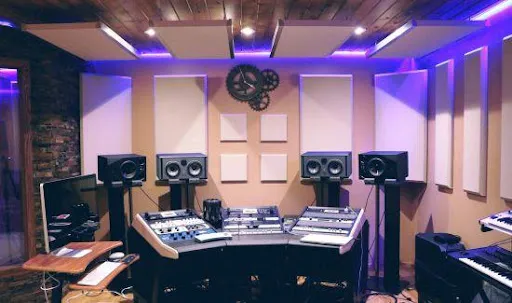Step into the world of recording studios and post-production magic, where music comes to life and movies are transformed into captivating masterpieces. Whether you’re an aspiring musician or a film enthusiast, understanding the inner workings of these creative spaces can give you a whole new appreciation for the artistry that goes into producing high-quality audio and visual content.
In this blog post, we’ll take you on a journey through different types of recording studios, uncover the intricacies of the recording process, delve into the fascinating realm of post-production, shed light on the importance it holds in filmmaking, and introduce you to the talented individuals known as music producers. So grab your headphones or settle in with some popcorn – let’s explore this enchanting world together!
Table of Contents
The Different Types of Recording Studios
Recording studios come in various shapes and sizes, each catering to specific needs and genres. First up, we have commercial recording studios – the bustling hubs where many popular artists lay down their tracks. These spaces are equipped with state-of-the-art equipment, multiple soundproof rooms, and a team of experienced engineers and producers to ensure top-notch quality.
On the other end of the spectrum, home recording studios offer a more budget-friendly option for musicians looking to create music in the comfort of their own space. With advancements in technology, it’s now possible to set up a professional-grade studio right at home with affordable gear such as audio interfaces and digital audio workstations.
Then there are specialized recording studios that focus on specific genres or instruments. For instance, there might be dedicated studios for classical orchestras or jazz ensembles with acoustics tailored specifically for those styles. Additionally, voice-over studios cater to actors needing a controlled environment to record dialogue for films or commercials.
The Recording Process
The recording process is a crucial step in creating high-quality audio content. It involves capturing and preserving sound using various equipment and techniques.
- First, the artist or band enters the studio and sets up their instruments, microphones, and other necessary gear. The engineer ensures that everything is properly connected and ready to go.
- Once everything is set up, the actual recording begins. This typically involves multiple takes of each song or track to ensure perfection. The engineer carefully monitors levels, adjusts settings, and captures every nuance of the performance.
- During recording sessions, artists may choose to record different parts separately or together as a group. This allows for flexibility in mixing later on.
- After all the tracks have been recorded, it’s time for editing and arranging. This includes cutting out any mistakes or unwanted sections, adjusting timing and pitch if needed, and organizing the tracks into a cohesive structure.
- Next comes mixing – blending all the individual tracks together to create a balanced final product. The engineer uses EQ (equalization), compression, reverb, panning techniques, and other tools to enhance each element of the mix.
- Lastly comes mastering – applying final touches such as overall EQ adjustments, dynamic range compression, etc., making sure that all songs on an album flow seamlessly together with consistent volume levels throughout
Post-Production
Post-production is a crucial step in the filmmaking process that often goes unnoticed by viewers. It encompasses all the work done after filming, including editing, sound design, visual effects, and color grading. These post-production techniques can take an ordinary scene and transform it into something extraordinary.

- Editing is where the magic happens. It involves selecting the best shots from hours of footage and arranging them to create a cohesive story. The editor carefully cuts together different angles, adds transitions, and manipulates pacing to enhance emotional impact.
- The sound design brings another layer of depth to a film. Foley artists recreate every day sounds like footsteps or door creaks in a studio to ensure everything sounds just right. Sound engineers then mix dialogue, music, and effects to create an immersive auditory experience for the audience.
- Visual effects are used to add elements that couldn’t be captured during filming or enhance existing scenes. Whether it’s creating fantastical creatures or blowing up buildings, VFX artists use sophisticated software tools to bring imagination to life on screen.
- Color grading is essential for establishing mood and enhancing storytelling through color manipulation. By adjusting contrast levels, saturation, and overall tone of each shot, colorists give films their distinctive look.
Importance of Post-production in the Filmmaking Process?
The filmmaking process is a multi-faceted journey that involves numerous stages, from pre-production to production and finally post-production. While each stage plays a crucial role in bringing a film to life, it is in post-production where the magic truly happens.
Post-production encompasses everything that occurs after the principal photography has been completed. It involves editing, sound design, visual effects, color grading, and more. This phase allows filmmakers to refine their vision and transform raw footage into a polished final product.
One of the key reasons why post-production is so important lies in its ability to enhance storytelling. Through skillful editing techniques and strategic use of sound and visuals, filmmakers can create emotion, suspense, and impact. The pacing of a scene or the placement of specific shots can significantly influence how an audience perceives and engages with a film.
Music Producers

Music Producers are the unsung heroes behind some of our favorite songs. They play a crucial role in the recording studio, working closely with artists to bring their musical vision to life. These talented individuals possess a keen ear for sound and an innate ability to shape and enhance a song.
One of the primary responsibilities of music producers is overseeing the entire recording process. From selecting the right studio and equipment to guiding artists through their performances, they ensure that every element comes together seamlessly.
Conclusion
In this blog post, We have learned about the different types of recording studios and how they cater to various needs in the music industry. From home studios to professional facilities, each one offers a unique experience for artists and producers.
We have also delved into the recording process itself, understanding the importance of capturing high-quality audio through equipment, techniques, and skilled engineers. The art of post-production has been unveiled as well, showcasing its significance in enhancing sound recordings and creating immersive experiences for listeners.
Now it’s time for you to explore these incredible realms firsthand! Step into a recording studio near you or dive deeper into online resources that can help you further understand this enchanting world.
















